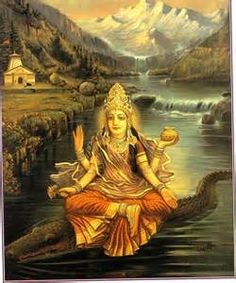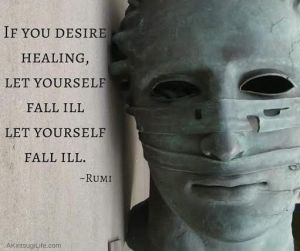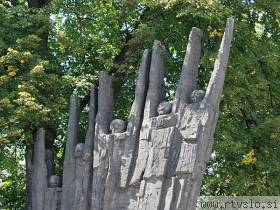 I began keeping synchronicity journals 11 years ago, but have never gotten over the excitement I feel as clusters of meaningful events form around a particular theme. That happened recently around the concept of “Brokenness.” First, I came across this picture that a friend posted on social media. The picture—without any intro or explanation as to its meaning—grabbed me personally. As I looked at it, I thought, “Yes! I’ve encountered that old Croc before; sometimes on top and sometimes completely torn apart in the process of grappling with it.”
I began keeping synchronicity journals 11 years ago, but have never gotten over the excitement I feel as clusters of meaningful events form around a particular theme. That happened recently around the concept of “Brokenness.” First, I came across this picture that a friend posted on social media. The picture—without any intro or explanation as to its meaning—grabbed me personally. As I looked at it, I thought, “Yes! I’ve encountered that old Croc before; sometimes on top and sometimes completely torn apart in the process of grappling with it.”
When I connect with the Magical Child archetype, a theme I’ve written about before in this blog, I know how to ride the Beast within my own psyche with equanimity. But, no matter what we do, there is no guarantee that any of us will forever remain “on top.” It is the job of Life on this beautiful/ailing planet to shake things up and break us apart in order that we might be put back together in a way more germane to the evolution of the whole Self.
After giving the theme of Brokenness much consideration, I came across a photo on the Internet that I assumed the picture above had been based on: Akhilandeshvari, the goddess known in Hindu iconology as the one who is Never-Not-Broken.
 Akhilandeshvari represents all the disparate parts of self that never really come together, but can be carried by a strong center that has been rolled and polished in the sands of grief where we’ve been dumped after riding the crest of a wave that we thought would never break. We find ourselves in a mess, ego-skinned and bleeding and feeling as if our perception of self will never not be torn asunder. However, we find that this breaking of the hold of Ego with its attachments to fear, hubris or whatever holds us hostage, eventually yields a more refined center. When this happens, we are forever changed and cannot go back to perceiving life in exactly the same way as before. Like the oyster that must bear a certain amount of irritation before the treasure of the pearl within is formed, we must surrender to the process of inner reconstruction and transformation.
Akhilandeshvari represents all the disparate parts of self that never really come together, but can be carried by a strong center that has been rolled and polished in the sands of grief where we’ve been dumped after riding the crest of a wave that we thought would never break. We find ourselves in a mess, ego-skinned and bleeding and feeling as if our perception of self will never not be torn asunder. However, we find that this breaking of the hold of Ego with its attachments to fear, hubris or whatever holds us hostage, eventually yields a more refined center. When this happens, we are forever changed and cannot go back to perceiving life in exactly the same way as before. Like the oyster that must bear a certain amount of irritation before the treasure of the pearl within is formed, we must surrender to the process of inner reconstruction and transformation.
The story of Akhilandeshvari is about learning that we are all broken in ways that we ourselves are not aware. It is also about learning to have compassion for the lack of awareness in others, as we recognize that this is also our own state of being. I thought, “Okay. I get it.” but as the universe likes to drive home a point, it wasn’t yet done with me.
Shortly thereafter, I came to a meme containing this Rumi quote: “If you desire healing, let yourself fall ill. Let yourself fall ill…”

Whoa! Now, that seemed extreme. Then a friend of mine, whom I was visiting in Texas and who knew nothing about my thoughts about Rumi or brokenness at that time, suggested we watch the movie “Off the Map,” starring Joan Allen, Valentina de Angelis, and Sam Elliott.
Description and review from IMDb:
“An 11-year-old girl watches her father come down with a crippling depression. Over one summer, she learns answers to several mysteries and comes to terms with love and loss.”
“Off the Map” is an “old-fashioned” film that made me feel, in the immortal words of Frank Zappa, that it’s f*cking great to be alive. This film took me to a place in my heart I haven’t been since the wonderful Bill Forsyth (“Local Hero”) faded from the movie-making scene. It is high time for humane, gentle, wholly original stories of people and places off the map (or in our technological dystopia, perhaps `off the radar screen’ would be more appropriate) to fill our movie dreamscape again. New Mexico is the only place in the United States this could have been filmed because, indeed, only the Land of Enchantment could have fit this gorgeous, lyrical story so well.”
For me, “Off the Map” depicts in living color the theme of brokenness and the tumbling and polishing of egos this family underwent through each person’s individual grief over illness and loss. Sam Elliott did a super job of depicting depression’s full-blown power as it laid his character lower than low, eventually serving to move him and his whole family in the direction of wholeness. The movie also has an added relevance for me connected to my love of New Mexico (if you’ve read any of my blogs, you know that about me), as well as its theme built around an old tax issue the adults in the film must deal with. Interestingly, “old taxes” were to appear in my own life a few weeks later upon my return home to California, where I found a letter waiting for me from the California Tax Franchise. I know that this might seem strange to those of a more logical bent, but because of the gentle way the tax issue was worked out in the film, I suspected that all was going to end well for me as well. That is turning out to be true.
Continuing with the theme of brokenness—this time in the Collective—the next morning my friend Lenora sent out a public “Salud!” to her artist Uncle, Drago Trsar, which I have partially reproduced here:
 “Happy Belated Birthday to my beloved Uncle Drago Trsar, whose personal gift and mission as one of the best known post World War II sculptors in Europe was to depict what the individual internalizes from society and what society does, from the individual. Being in your studio to touch and talk to your magnificent sculpture and the miniatures for your large-scale installations was seminal (and such fun) creativity fodder for me. Human hearts can forge great art from cultural heartbreak, as you did and the greatest art IS a healthy, thriving, inclusive social collective…”
“Happy Belated Birthday to my beloved Uncle Drago Trsar, whose personal gift and mission as one of the best known post World War II sculptors in Europe was to depict what the individual internalizes from society and what society does, from the individual. Being in your studio to touch and talk to your magnificent sculpture and the miniatures for your large-scale installations was seminal (and such fun) creativity fodder for me. Human hearts can forge great art from cultural heartbreak, as you did and the greatest art IS a healthy, thriving, inclusive social collective…”
What I’ve learned from this cluster of meaningful events is that we all experience brokenness, in the collective and within ourselves. There is never a time when there is no brokenness in the world. The good news is that the human spirit strives again and again toward healing and wholeness as well as spiritual and psychological evolution, no matter how slow going and convoluted the process may seem…
Ciao,
Jenna

I’m thinking about brokenness and dismemberment for a few reasons, one being that a friend and I are planning a hospice workshop to address the experience of feeling dismembered by grief–and letting ourselves “fall ill.” The other is feeling uncentered and ungrounded since my brother’s death in a subtle but not overwhelming way. I could override and ignore, but there’s an important message there. Of course, there is that famous Rumi quote about the importance of the crack in us. After returning home from my brother’s memorial service yesterday, I remind myself that I won’t always feel broken. Even if physical wounds can’t be healed, psyche’s wounds have a way of teaching and mending.
Gosh, Elaine, I don’t mean to wait so long to respond to your comments. I’ve been meaning to change my blog email address so responses are routed to my Gmail account. The Yahoo account is almost defunct and I hardly ever check it. That said, I do appreciate the fact the you always make a point of commenting directly in my blog. Most people leave comments on my FB page, and that is nice, too. But I do like to find comments here (usually yours) as well. I sure wish I could attend your grief workshop with you and your friend at Hospice. I think that the work you are doing is so important and healing to others. You’ve taken your own journey through grief, extracted all the most vital and important aspects of allowing grief to have its say, and shared the Gold you’ve gotten out of the process with others. I know these past few months have been extremely difficult ones for you with the passing of your brother. Big hugs to you…now in cyberspace and hopefully in person, sooner than later…